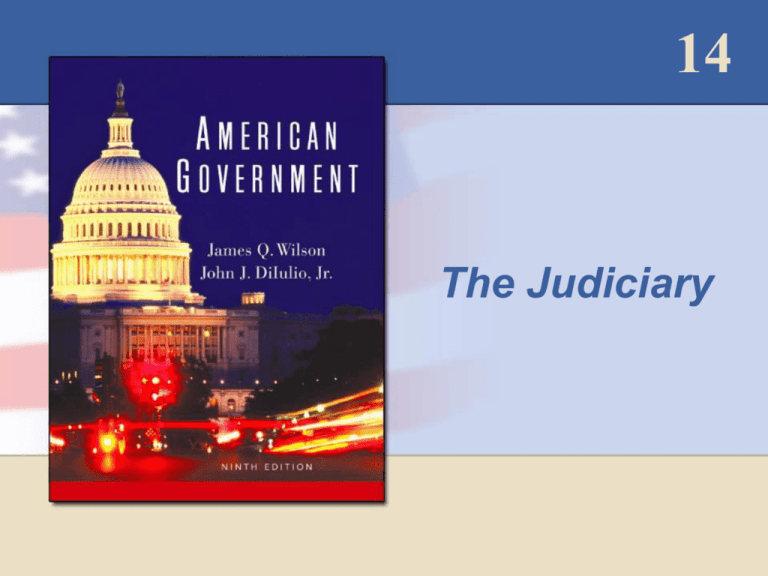
14
The Judiciary
Map 14.1: U.S. District and Appellate Courts
Copyright © Houghton Mifflin Company. All rights reserved.
14 - 2
Early History of the Court
Institutional Legitimacy
1. Defeat of politically-motivated impeachment of Justice Chase- judicial independence
2. Issuance of a single majority opinion that enabled the Court to speak with one voice
3. Judicial Review established in Marbury v. Madison (1803), creating an equal
partnership with other branches
Decision-making eras
1. 1787-1865: National Supremacy, Federal Legitimacy, and Slavery
a.
b.
Martin v. Hunter’s Lessee (1816)- binding interpretations of federal law on state courts
McCulloch v. Maryland (1819)- federal supremacy. However, not applied in practice until after
civil war. In Dred Scott v Sanford (1857), federal law overturned for only 2nd time. Court’s
reluctance to use Judicial Review made its use uncertain.
2. 1865-1937: Relationship between Government and Economy
a.
b.
c.
Court acts to support property rights under the 14th Amendment’s Due Process clause (intended?)
Laissez-faire. However, 80% state regs. upheld 1887-1910. Inconsistencies became common
“Switch in time that saves nine.” NLRB v. Jones and Laughlin (1937), Carolene Products (1939)
3. 1938-present: Protection of Civil Liberties
a. Personal liberties protected, i.e. free speech, racial integration. Such cases less today (Reagan, Bush)
4. 1997- present: Federalism revisited?
a. Ex. Printz v. U.S. (1997): dual federalism? Contrast with South Dakota v. Dole (1986)
Copyright © Houghton Mifflin Company. All rights reserved.
14 - 3
Table 14.1: Chief Justices of the United States
Copyright © Houghton Mifflin Company. All rights reserved.
14 - 4
“Deciding to Decide”
Steps in the Decisionmaking Process- Strategery?
1. Dispute pyramids- 10% of all cases make it to court
2. Granting Certiorari- 8,000 appeals annually, <100 cases heard per Rehnquist term
a.
Impact on no cert.- case stands (MA gay marriage). Implications?
3. Oral Arguments- organized chaos, strategic questioning
a.
b.
c.
30 min. per side, Solicitor General gets 10 automatically
Rarely 30 seconds elapse before interruption
Attack or lead attorney
4. The Conference- seniority, decorum, and influence
a.
Opinion writers chosen, based on make up of majority and seniority
1.
b.
c.
Majority, concurring, and dissenting opinions
Voting decisions: attitudinal (Segal and Spaeth) or strategic (Epstein and Knight)
“Lobbying?” Justices insist not; however, Kennedy’s “switch” 10 hrs. before Bush v. Gore
5. The decision- quorum with 6, ties go to previous courts’ decision.
a.
Only amicus curaie briefs with statistical significance: SG’s
6. Greater fragmentation in voting: 19th c- 90% unanimity. 1995- 38.7%
a.
b.
Concurring opinions are important in deciding whether Court is creating precedent (Brown)
“Occasionally,” Lawrence Baum explains, “ . . . no opinion gains . . . majority . . . [therefore]
there is a decision but no authoritative interpretation of the legal issues in the case.” (Gretz)
Copyright © Houghton Mifflin Company. All rights reserved.
14 - 5
Table 14.2: How Partisanship Affects Judicial
Attitudes
Copyright © Houghton Mifflin Company. All rights reserved.
14 - 6
Strategic Retirements?
See the following:
1. “Strategic Retirements” p. 423
2. “Litmus Test” p. 414
3. “What Would You Do?” p. 425
4. Note Bene:
a.
b.
Civil vs. Criminal law distinction
Burdens of guilt for juries
1.
2.
Beyond a reasonable doubt (100%) vs. preponderance of the evidence (50 + 1%)
De facto vs. De Jure segregation
3.
4.
5.
Senatorial Courtesy
In forma pauperis and Gideon v. Wainright (1963)
Fee shifting, standing, sovereign immunity, Per curiam, stare decisis
Copyright © Houghton Mifflin Company. All rights reserved.
14 - 7
Figure 14.1: Female and Minority Judicial
Appointments, 1963-2000
Source: Harold W. Stanley and Richard Niemi, Vital Statistics on American Politics, 2001-2002 (Washington, D.C.: Congressional
Quarterly Press, 2001), table 7.5.
Copyright © Houghton Mifflin Company. All rights reserved.
14 - 8
Figure 14.1: Female and Minority Judicial
Appointments, 1963-2000 (cont’d)
Source: Harold W. Stanley and Richard Niemi, Vital Statistics on American Politics, 2001-2002 (Washington, D.C.: Congressional
Quarterly Press, 2001), table 7.5.
Copyright © Houghton Mifflin Company. All rights reserved.
14 - 9
Figure 14.1: Female and Minority Judicial
Appointments, 1963-2000 (cont’d)
Source: Harold W. Stanley and Richard Niemi, Vital Statistics on American Politics, 2001-2002 (Washington, D.C.: Congressional
Quarterly Press, 2001), table 7.5.
Copyright © Houghton Mifflin Company. All rights reserved.
14 - 10
Table 14.3: Supreme Court Justices in Order of
Seniority, 1999
Copyright © Houghton Mifflin Company. All rights reserved.
14 - 11
Figure 14.2: The Jurisdiction of the Federal Courts
Copyright © Houghton Mifflin Company. All rights reserved.
14 - 12
Figure 14.3: Patterns of Public Confidence in the
Court
Source: Updated from The Gallup Poll: Public Opinion 1991 (Wilmington, Del.: Scholarly Resources, Inc., 1992), 213.
Copyright © Houghton Mifflin Company. All rights reserved.
14 - 13
The Power of the Federal Judiciary
Strict Constructionist Approach
- judges should confine themselves to applying those rules that are stated clearly or
implied by the Constitution
Activist Approach
- judges should discover the general principles underlying the constitution and amplify
those principles on the basis of some moral or economic philosophy. Today: activists
are liberals; 1930’s: opposite was true.
Barriers to getting to court
1. Standing
a.
b.
c.
Indigence
Fee shifting
Class action suits
2. Sovereign immunity
3. Political questions
4. Remedies
Powers of the Court- not “too many lawyers”
1. Provide solutions to problems
2. Have increased in power with government
Checks on the Court- political appointments to S. Ct. have largely failed
Copyright © Houghton Mifflin Company. All rights reserved.
14 - 14



